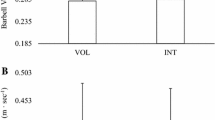Abstract
Purpose
Rest-pause (4-s unloaded rest between repetitions) training effects on one repetition maximum (1 RM), lifting volume, and neural activation via electromyography (EMG) are currently vague in the literature and can benefit strength and conditioning professionals for resistance training programme design. Therefore, this study compared 1 RM, neural activation via (EMG), and volume differences between rest-pause vs. traditional resistance training.
Methods
Trained males (N = 20) were randomly assigned to either a rest-pause or a traditional training group. Pre- and post-1 RM testing was recorded. Training sessions were completed twice a week for 4 weeks and consisted of four sets of bench press to volitional fatigue at 80% of pre-test 1 RM with a 2-min rest between sets. Total volume completed was recorded on each training day. Neural activation of the pectoralis major was measured on the first and last training days.
Results
A two-way repeated-measures ANOVA indicated both groups significantly increased their 1 RMs following the 4-week training protocol (p < .05). However, no significant differences were found in 1 RM and neural activation between the two groups (p > .05). An independent samples t test indicated that total volume lifted was significantly higher for the rest-pause group (56,778 vs. 38,315 lbs; p < .05) throughout the protocol and independently during weeks 2, 3, and 4.
Conclusions
While strength and neural activation changes did not differ between groups, both increased 1 RMs and the rest-pause group achieved greater increases in volume than the traditional group. If volume is the focus of training, the rest-pause method should be utilized.
Similar content being viewed by others

Abbreviations
- ATP-PCr:
-
Adenosine triphosphate phosphocreatine
- ANOVA:
-
Analysis of variance
- PCr:
-
Creatine phosphate
- EMG:
-
Electromyography
- RM:
-
Repetition maximum
- RMS:
-
Root mean square
References
Allen CC, Dean KA, Jung AP, Petrella JK (2013) Upper body muscular activation during variations of push-ups in healthy men. Int J Exerc Sci 6(4):278–288
Baechle TR, Earle RW (2008) Essentials of strength training and conditioning. Champaign, Illinois
Bogdanis GC, Nevill ME, Boobis LH, Lakomy HK, Nevill AM (1995) Recovery of power output and muscle metabolites following 30 s of maximal sprint cycling in man. J Physiol 482(2):467–480
Brooks GA, Fahey TD, White TP (1996) Exercise physiology: human bioenergetics and its applications, 2nd edn. Mayfield Publishing Company, Houston
Dawson B, Goodman C, Lawrence S, Preen D, Polglaze T, Fitzsimons M, Fournier P (1997) Muscle phosphocreatine repletion following single and repeated short sprint efforts. Scand J Med Sci Sports 7:206–213
DiPrampero PE, Margaria R (1969) Mechanical efficiency of phosphagen (ATP + CP) splitting and its speed of resynthesis. Pflugers Arch 308:197–202
Hakkinen K, Newton RU, Gordon SE et al (1998) Changes in muscle morphology, electrographic activity, and force production characteristics during progressive strength training in young and older men. J Gerontol 53(6):415–423
Harris RC, Edwards RN, Hultman E, Nordesjo LO, Nulind B, Sahlin K (1976) The time course of phosphorylcreatine resynthesis during recovery of the quadriceps muscle in man. Pfluger Arch 367:137–142
Hass CJ, Garzarella L, Hoyos DD, Pollock ML (2000) Single versus multiple sets in long-term recreational weightlifter. Med Sci Sports Exerc 32(1):235–242
Keogh JWL, Wilson GJ, Weatherby RP (1999) A cross-sectional comparison of different resistance training techniques in the bench press. J Strength Cond Res 13(3):247–258
Krol H, Sobota G, Nawrat A (2007) Effect of electrode position on emg recording in pectoralis major. J Hum Kinet 17:105–112
Lawton TW, Cronin JB, Lindsell RP (2006) Effect of interrepetition rest intervals on weight training repetition power output. J Strength Cond Res 20(1):172–176
Marshall PWM, Robbins DA, Wrightson AW, Siegler JC (2012) Acute neuromuscular and fatigue responses to the rest-pause method. J Sci Med Sport 15:153–158
McArdle WD, Katch FI, Katch VL (2014) Exercise physiology, nutrition, energy, and human performance, 8th edn. Baltimore, Maryland
Miranda H, Fleck SJ, Simao R, Barreto AN, Dantas EHM, Novaes J (2007) Effect of two different rest period lengths on the number of repetitions performed during resistance training. J Strength Cond Res 21(4):1032–1036
Ostrowski KJ, Wilson GJ, Weatherby R, Murphy PW, Lyttle AD (1997) The effect of weight training volume on hormonal output and muscular size and function. J Strength Cond Res 11(1):148–154
Pescatello LS (2014) ACSM’s guidelines for exercise testing and prescription. Philadelphia, Pennsylvania
Rhea MR, Alvar BA, Ball SD, Burkett LN (2002) Three sets of weight training superior to 1 set with equal intensity for eliciting strength. J Strength Cond Res 16(4):525–529
Robinson JM, Stone MH, Johnson RL, Penland CM, Warren BJ, Lewis RD (1995) Effects of different weight training exercise/rest intervals on strength, power, and high intensity exercise endurance. J Strength Cond Res 9:216–221
Seynnes OR, Boer MD, Narici MV (2007) Early skeletal muscle hypertrophy and architectural changes in response to high-intensity resistance training. J Appl Physiol 102(1):368–373
Author information
Authors and Affiliations
Corresponding author
Ethics declarations
Conflict of interest
The authors declare that they have no conflict of interest.
Additional information
Communicated by Peter Krustrup.
Research conducted at the Exercise Science Research Laboratory at Middle Tennessee State University.
Rights and permissions
About this article
Cite this article
Korak, J.A., Paquette, M.R., Brooks, J. et al. Effect of rest-pause vs. traditional bench press training on muscle strength, electromyography, and lifting volume in randomized trial protocols. Eur J Appl Physiol 117, 1891–1896 (2017). https://doi.org/10.1007/s00421-017-3661-6
Received:
Accepted:
Published:
Issue Date:
DOI: https://doi.org/10.1007/s00421-017-3661-6



